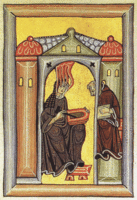News
Catherine Hannon dolc
1 December 2012
 On Sunday, October 7, 2012, the opening Mass for the Synod on the New Evangelisation was celebrated at St Peter’s in Rome and the Doctorates on St Hildegard of Bingen and St John of Avila were promulgated.
On Sunday, October 7, 2012, the opening Mass for the Synod on the New Evangelisation was celebrated at St Peter’s in Rome and the Doctorates on St Hildegard of Bingen and St John of Avila were promulgated.
At about the same time, a large group of people from across the Wellington churches met at St Joseph’s Mt Victoria to acclaim Hildegard and rejoice that at last the Church is recognising her outstanding life and works.
Margaret Butler OP, Moyra Pearce, Clare Fussell and Catherine Hannan dolc led a liturgy highlighting Hildegard’s contributions to music and art and several of the participants shared their particular interest in her.
Apart from being only the fourth woman in the history of the church to receive this honour, Hildegard was an extraordinary woman.
Her life spanned much of the 12th century, being born in Germany in 1098 and dying in 1179. She wrote extensively, composed music which subverted the principles of liturgical music of the time, was a philosopher, ecologist, mystic, Benedictine abbess and visionary.
She wrote theological, botanical and medicinal texts, as well as letters to people such as Bernard of Clairvaux, founder of the reformist Cistercian monastic order. Bernard sent the text of some of her work to Pope Eugenius III who endorsed her works and visions, giving her approval to document her visions as revelations from the Holy Spirit.
Hildegard’s world at that time was in some ways not unlike our own. There was an atmosphere of fear. New ideas were condemned as heresy. What helped Hildegard navigate through this minefield?
She was a prophet in that she lived immediately before Francis of Assisi, Dominic, Thomas Aquinas and the great Mechtilde of Magdeburg. Perhaps it is providential that she has remained hidden until now so that her impact on our time may be more beneficial, in releasing the spring of new discoveries into exploring God in the gospel as revealed by Jesus, the Word.
Amazingly, at 60 she did the unthinkable for her time. She travelled to cathedrals, churches, abbeys and monasteries preaching. This was at a time when only men preached and women were safely enclosed within monastic walls.
What an inspiration for us today: a Doctor of the Church who can speak the Word of God to all who listen.
Image: Illumination from Hildegard’s Scivias showing her receiving a vision and dictating to Volmar, her confessor, scribe and secretary.